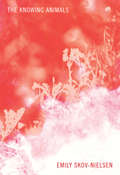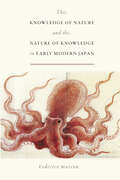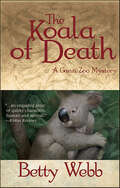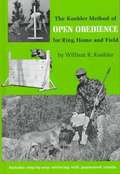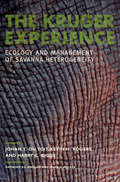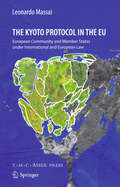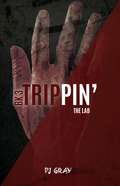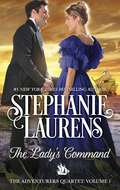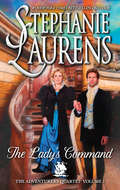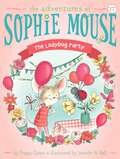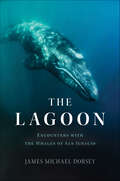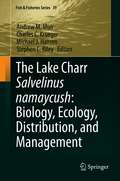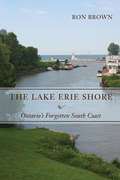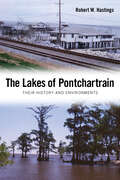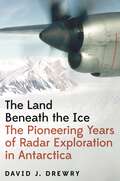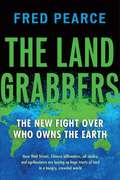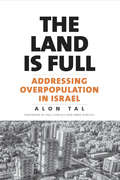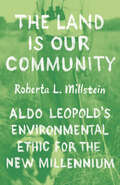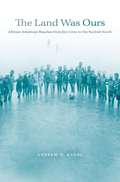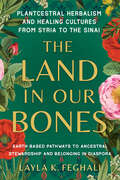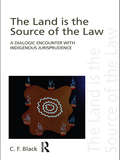- Table View
- List View
The Knowing Animals
by Emily Skov-NielsenPoems that sing, in various notes of female voice, the human being as an embodied, contemplative, feeling animal. In Skov-Nielsen's thrumming debut, The Knowing Animals, our consciousness is interconnected with the surrounding trees, bugs, rivers, atmospheres, and cosmos. Here, flowers escape Victorian domestication and ally with girls' green powers of attraction. Here, the social politeness of motherly domesticity and the raw dangers of adolescent sexual awakening are shot through with blood pulsing under the skin, with oxygen exchanged in gasps of breath. Here, everything tender and petalling is also raw and mothervisceral. This is a book of entanglements: the poems twist and turn through a plurality of metaphorical associations involving botany, zoology, astronomy, biology, psychology, and mythology to complicate and expand human conceptions of nature. At the same time, they explore themes such as motherhood, pregnancy and birth, sexuality, adolescence, and the rise of technology, all the while shifting through a variety of tones: romantic, mythological, religious, scientific, wistful, and playful.
The Knowledge of Nature and the Nature of Knowledge in Early Modern Japan (Studies of the Weatherhead East Asian Institute)
by Federico MarconBetween the early seventeenth and the mid-nineteenth century, the field of natural history in Japan separated itself from the discipline of medicine, produced knowledge that questioned the traditional religious and philosophical understandings of the world, developed into a system (called honzogaku) that rivaled Western science in complexity--and then seemingly disappeared. Or did it? In The Knowledge of Nature and the Nature of Knowledge in Early Modern Japan, Federico Marcon recounts how Japanese scholars developed a sophisticated discipline of natural history analogous to Europe's but created independently, without direct influence, and argues convincingly that Japanese natural history succumbed to Western science not because of suppression and substitution, as scholars traditionally have contended, but by adaptation and transformation. The first book-length English-language study devoted to the important field of honzogaku, The Knowledge of Nature and the Nature of Knowledge in Early Modern Japan will be an essential text for historians of Japanese and East Asian science, and a fascinating read for anyone interested in the development of science in the early modern era.
The Koala of Death: A Gunn Zoo Mystery (Gunn Zoo Series #2)
by Betty WebbWhen zookeeper Theodora "Teddy" Bentley fishes the body of Koala Kate out of Gunn Landing Harbor, she discovers that her fellow zookeeper didn't drown; she was strangled. The clues to Kate's killer implicate other animal keepers at Gunn Zoo, including Outback Bill, marsupial keeper and Kate's Aussie ex-boyfriend; and Robin Chase, the big cat keeper who's got it in for Teddy. Also displaying suspicious behavior are several "liveaboarders" at the harbor; Speaks-To-Souls, a shady "animal psychic;" and even Caro, Teddy's much-married, ex-beauty queen mother.But murderers aren't all Teddy has to worry about. Her embezzling father is still on the run from the Feds, and the motor on her houseboat is failing. To pay for the repairs, Teddy agrees to appear on a weekly live television broadcast featuring misbehaving animals that range from a cuddly koala to a panicky wallaby - and all hell breaks loose in the TV studio. All the while, the killer is narrowing in on Teddy....
The Koehler Method of Open Obedience for Ring, Home and Field
by William R. KoehlerThis book builds on the skills taught in the Koehler Method of Dog Training. It covers advanced obedience skills such as retrieving, jumping, and off-leash work.
The Kruger Experience: Ecology And Management Of Savanna Heterogeneity
by Brian Walker Anthony R.E. Sinclair Kevin H. Rogers Johan T. du Toit Harry C. BiggsThe Kruger Experience is an invaluable new resource for scientists and managers involved with large, conserved ecosystems as well as for conservation practitioners and others with interests in adaptive management, the societal context of conservation, links between research and management in parks, and parks/academic partnerships.
The Kyoto Protocol in the EU
by Leonardo MassaiThe participation of the European Community and the Member States in the international climate change regimes is a complex issue. In the case of the Kyoto Protocol, this is rendered more complicated by the fact that, for the purposes of Article 4 of the Kyoto Protocol, the membership of the European Community and Member States is frozen at a particular point in time. The result of this is that, under international law, the European Community and a part of the Member States (EU15) have agreed to jointly fulfil some of those obligations, whereas under community law all Member States share a certain degree of responsibility to meet the obligations created by the Kyoto Protocol. This book analyses in great detail the Kyoto Protocol and the obligations established, such as monitoring and reporting obligations, eligibility criteria and reduction commitments.
The Lab (Trippin' #3)
by P. J. GrayThe Lab: Book-3 - The worst snowstorm in years. They were trapped in a farmhouse. The owners seemed innocent enough. Quiet. Stoic. But something was not quite right. The author Introduces emergent teen readers to the concept of a series, where each book leaves wanting more. Incorporating vivid graphic elements, this three-book series will attract students interested in reading edgier material. Each 64-page book is approximately two thousand five hundred words. <p><p> Troy and Justin have been through a lot together. But Troy has had enough of street life. He cleans up his act. Finds a job. Takes classes at night. Justin is the same fun-loving guy he's always been. He hops from job to job. But he prefers mooching off his girlfriend. About to get dumped, Justin is glum. Then Troy suggests a road trip.
The Lady's Command (The Adventurers Quartet #1)
by Stephanie LaurensDiscover THE ADVENTURERS QUARTET, a riveting blend of Regency-era high seas adventure, intrigue and romance, only from #1 New York Times bestselling author STEPHANIE LAURENS. His to cherishDeclan Frobisher chose Lady Edwina Delbraith as his wife. Scion of a bold, seafaring dynasty, he’s accustomed to getting his way— Edwina would be the woman who graced his arm, warmed his bed and remained safely at home when he returned to sea. But once the knot is tied, Declan discovers Edwina is unconventional and strong-willed, and his marriage promises to be as tempestuous as the high seas. Hers to commandEdwina’s fairy-princess beauty hides a spine of steel. Born into the aristocracy—born to rule—and with Declan’s ring gracing her finger, she expects to forge a marriage by his side. Then bare weeks into their honeymoon, Declan is recruited to sail on a secret mission. Edwina— naturally—declares she must accompany him. Theirs to conquerFacing unforeseen perils and unexpected enemies while battling to expose a dastardly scheme, Declan and Edwina discover that their unusual marriage demands something they both possess—bold and adventurous hearts. JOIN THE ADVENTURERS—four couples whose passionate voyages will transport you. Start the journey here and follow the adventures, the mysteries and the romances to the cataclysmic end!Originally published in 2015
The Lady's Command (The Adventurers Quartet)
by Stephanie LaurensHow does marriage work? If convention is set aside and is no longer there to guide...what then?Stephanie Laurens, #1 New York Times bestselling author of the beloved Cynster novels, brings you THE ADVENTURERS QUARTET, a riveting blend of Regency-era high seas adventure, a mystery shrouded in the heat of tropical jungles, and the passionate romances of four couples and their unexpected journeys into love. The instant Captain Declan Frobisher laid eyes on Lady Edwina Delbraith, he knew she was the lady he wanted as his wife. The scion of a seafaring dynasty accustomed to success, he discovered that wooing Edwina was surprisingly straightforward-not least because she made it plain that she wanted him as much as he wanted her.Declan's vision of marriage was of a gently-reared wife to grace his arm, to manage his household, and to bear his children. He assumed that household, children, and wife would remain safely in England while he continued his life as an explorer sailing the high seas.Declan got his wish-up to a point. He and Edwina were wed. As for the rest-his vision of marriage...Aunt of the young Duke of Ridgware and sister of the mysterious man known as Neville Roscoe, London's gambling king, even before the knot was tied Edwina shattered the illusion that her character is as delicate, ethereal, and fragile as her appearance suggests. Far from adhering to orthodox mores, she and her ducal family are even more unconventional than the Frobishers.Beneath her fairy-princess exterior, Edwina possesses a spine of steel-one that might bend, but will never break. Born to the purple-born to rule-she's determined to rule her life. With Declan's ring on her finger, that means forging a marriage that meets her needs as well as his.But bare weeks into their honeymoon, Declan is required to sail to West Africa. Edwina decides she must accompany him.A secret mission with unknown villains flings unexpected dangers into their path as Declan and Edwina discover that meeting the challenge of making an unconventional marriage work requires something they both possess-bold and adventurous hearts.The first voyage is one of exploration, the second one of discovery. The third journey brings maturity, while the fourth is a voyage of second chances.Start the journey here and follow the adventure, the mystery, and the romances to the cataclysmic end.Praise for the works of Stephanie Laurens"Stephanie Laurens' heroines are marvelous tributes to Georgette Heyer: feisty and strong." -Cathy Kelly"Stephanie Laurens never fails to entertain and charm her readers with vibrant plots, snappy dialogue, and unforgettable characters." -Historical Romance Reviews"Stephanie Laurens plays into readers' fantasies like a master and claims their hearts time and again." -Romantic Times Magazine
The Ladybug Party (The Adventures of Sophie Mouse #17)
by Poppy GreenSophie helps a ladybug with a surprise party in this seventeenth adorable book of The Adventures of Sophie Mouse series!Sophie meets a ladybug setting up for a surprise party in Silverlake Forest. Sophie offers to run some errands in town to help her new friend. But by the time Sophie gets to town, she&’s forgotten what the ladybug said! Will Sophie&’s friends be able to help her in time to pull off the big surprise? With easy-to-read language and illustrations on almost every page, the Adventures of Sophie Mouse chapter books are perfect for beginning readers.
The Lagoon: Encounters with the Whales of San Ignacio
by James Michael DorseyA voyage to a magical marine haven, the San Ignacio Lagoon in Baja, Mexico, where the connection between man and beast is like no other on Earth. Once a killing ground for whalers hunting a leviathan they called the “devilfish,” the San Ignacio Lagoon in Baja, Mexico, is now an environmental and spiritual sanctuary—the only place in the world where animals in their natural aquatic environment routinely seek out human contact. A nursery for the gray whale since before recorded history, the lagoon and its stories, told here by resident naturalist James Michael Dorsey, illuminate the magic of human connection to animals, and what those bonds teach us about ourselves and our purpose on this shared planet. Weaving two decades of San Ignacio adventures in the company of his wife Irene with the fascinating history of the lagoon, Dorsey vividly captures the lively people of Baja, like the mystical godfather of whale-watching, Pachico Mayoral, as well as the whales he’s bonded with over the years, like Slackjaw, Patch, and Dervish—their individual personalities, their epic migration to and from the Pacific Northwest, and the science behind their behavior. Looming over his journeys are the many dangers to the area, from the Mitsubishi Corporation’s attempts to build salt works to plans for resort development on the Baja coast, to pollution and climate change, and even to the orcas who hunt the gray whales. The future of this refuge has never looked more threatened. A tale of wondrous bonds between the intelligent, spirited gray whales and the men, women, and children from around the world who come to this place to touch, kiss, and play with them—The Lagoon is a testament to the importance of preserving these animals and their natural habitats.
The Lake Charr Salvelinus namaycush: Biology, Ecology, Distribution, and Management (Fish & Fisheries Series #39)
by Andrew M. Muir Charles C. Krueger Michael J. Hansen Stephen C. RileyThe lake charr Salvelinus namaycush is a ubiquitous member of cold-water lake ecosystems in previously glaciated regions of northern continental U.S., Alaska, and Canada that often support important commercial, recreational, and subsistence fisheries. The lake charr differs from other charrs by its large size, longevity, iteroparity, top-predator specialization, reduced sexual dimorphism, prevalence of lacustrine spawning, and use of deepwater habitat. The species is remarkably variable in phenotype, physiology, and life history, some of which is reflected in its ecology and genetics, with as many as four morphs or ecotypes co-occurring in a single lake. The lake charr is often the top predator in these systems, but is highly adaptable trophically, and is frequently planktivorous in small lakes. The lake charr by their name highlights their common habitat, lakes both large and small, but often frequents rivers and occasionally moves into the Arctic Ocean. Movement and behaviour of lake charr are motivated by access to cool, well-oxygenated water, foraging opportunities, predator avoidance, and reproduction. Owing to their broad distribution and trophic level, the lake charr serves as a sentinel of anthropogenic change. This volume will provide an up-to-date summary of what is currently known about lake charr from distribution to genetics to physiology to ecology. The book provides a compilation and synthesis of available information on the lake charr, beginning with an updated distribution and a revised treatment of the paleoecology of the species. Understanding of ecological and genetic diversity and movement and behaviour of the species has advanced remarkably since the last major synthesis on the species over 40 years ago. Mid-sections of the book provide detailed accounts of the biology and life history of the species, and later sections are devoted to threats to conservation and fishery management practices used to ensure sustainability. A new standard lake charr-specific terminology is also presented. The book will be a valuable reference text for biologists around the world, ecologists, and fishery managers, and of interest to the angling public.
The Lake Erie Shore: Ontario's Forgotten South Coast
by Ron BrownThe Lake Erie shoreline has born witness to some of Ontario’s earliest history, yet remains largely unspoiled. Much of the area’s natural features - the wetlands, the Carolinian forests - and its built heritage - fishing ports and military ramparts - provide much of interest for vistors to the region. Ron Brown has traversed this most southern coast line in Ontario, fleshing out forgotten stories of the past, from accounts of the world’s largest freshwater fishing fleet, War of 1812 skirmishes, links with the Underground Railroad, forgotten outposts and canals, the introduction of wineries, and the legacy of the many appealing towns and villages that hug the shoreline.
The Lake Michigan Mermaid: A Tale in Poems (Made in Michigan Writers Series)
by Anne-Marie Oomen Linda Nemec FosterThe Lake Michigan Mermaid is a new tale that feels familiar. The breeze off the lake, the sand underfoot, the supreme sadness of being young and not in control—these sensations come rushing back page by page, bringing to life an ancient myth of coming of age in a troubled world. Freed from the minds of Linda Nemec Foster and Anne-Marie Oomen, the Lake Michigan mermaid serves as a voice of reason for when we’re caught in the riptide. This is a gripping tale in poems of a young girl’s desperate search for guidance in a world turned upside down by family and economic upheaval. Raised in a ramshackle cottage on the shores of Lake Michigan, Lykretia takes refuge in her beloved lake in the face of her grandmother’s illness and her mother’s eager attempts to sell their home following her recent divorce. One day Lykretia spots a creature in the water, something beautiful and inexplicable. Is it the mythical Lake Michigan mermaid, or an embodiment of the stories her grandmother told as dementia ravaged her mind? Thus begins a telepathic conversation between a lost young girl and Phyliadellacia, the mermaid who saves her in more ways than one. Accompanied by haunting illustrations, The Lake Michigan Mermaid offers a tender tale of friendship, redemption, and the life-giving power of water. As it explores family relationships and generational bonds, this book is an unforgettable experience that aims to connect readers of all ages.
The Lakes of Pontchartrain: Their History and Environments
by Robert W. HastingsA vital and volatile part of the New Orleans landscape and lifestyle, the Lake Pontchartrain Basin actually contains three major bodies of water—Lakes Borgne, Pontchartrain, and Maurepas. These make up the Pontchartrain estuary. Robert W. Hastings provides a thorough examination of the historical and environmental research on the basin, with emphasis on its environmental degradation and the efforts to restore and protect this estuarine system. He also explores the current biological condition of the lakes. Hastings begins with the geological formation of the lakes and the relationship between Native Americans and the water they referred to as Okwa'ta, the “wide water.” From the historical period, he describes the forays of French explorer Pierre Le Moyne D'Iberville in 1699 and traces the environmental history of the basin through the development of the New Orleans metropolitan area. Using the lakes for transportation and then recreation, the surrounding population burgeoned, and this growth resulted in severe water pollution and other environmental problems. In the 1980s, the Lake Pontchartrain Basin Foundation led a concerted drive to restore the lakes, an ongoing effort that has proved significant.
The Land Below, The Life Within (Volume 2: Incredible Facts About the Ocean)
by W. Wright RobinsonThere is an animal living in the ocean that cannot swim! There are whole mountain ranges below the water's surface! There are even rivers in the ocean!
The Land Beneath the Ice: The Pioneering Years of Radar Exploration in Antarctica
by David J. DrewryA wondrous story of scientific endeavor—probing the great ice sheets of AntarcticaFrom the moment explorers set foot on the ice of Antarctica in the early nineteenth century, they desired to learn what lay beneath. David J. Drewry provides an insider’s account of the ambitious and often hazardous radar mapping expeditions that he and fellow glaciologists undertook during the height of the Cold War, when concerns about global climate change were first emerging and scientists were finally able to peer into the Antarctic ice and take its measure.In this panoramic book, Drewry charts the history and breakthrough science of radio-echo sounding, a revolutionary technique that has enabled researchers to measure the thickness and properties of ice continuously from the air—transforming our understanding of the world’s great ice sheets. To those involved in this epic fieldwork, it was evident that our planet is rapidly changing, and its future depends on the stability and behavior of these colossal ice masses. Drewry describes how bad weather, downed aircraft, and human frailty disrupt the most meticulously laid plans, and how success, built on remarkable international cooperation, can spawn institutional rivalries.The Land Beneath the Ice captures the excitement and innovative spirit of a pioneering era in Antarctic geophysical exploration, recounting its perils and scientific challenges, and showing how its discoveries are helping us to tackle environmental challenges of global significance.
The Land Grabbers
by Fred PearceAn unprecedented land grab is taking place around the world. Fearing future food shortages or eager to profit from them, the world’s wealthiest and most acquisitive countries, corporations, and individuals have been buying and leasing vast tracts of land around the world. The scale is astounding: parcels the size of small countries are being gobbled up across the plains of Africa, the paddy fields of Southeast Asia, the jungles of South America, and the prairies of Eastern Europe. Veteran science writer Fred Pearce spent a year circling the globe to find out who was doing the buying, whose land was being taken over, and what the effect of these massive land deals seems to be. The Land Grabbersis a first-of-its-kind exposé that reveals the scale and the human costs of the land grab, one of the most profound ethical, environmental, and economic issues facing the globalized world in the twenty-first century. The corporations, speculators, and governments scooping up land cheap in the developing world claim that industrial-scale farming will help local economies. But Pearce’s research reveals a far more troubling reality. While some mega-farms are ethically run, all too often poor farmers and cattle herders are evicted from ancestral lands or cut off from water sources. The good jobs promised by foreign capitalists and home governments alike fail to materialize. Hungry nations are being forced to export their food to the wealthy, and corporate potentates run fiefdoms oblivious to the country beyond their fences. Pearce’s story is populated with larger-than-life characters, from financier George Soros and industry tycoon Richard Branson, to Gulf state sheikhs, Russian oligarchs, British barons, and Burmese generals. We discover why Goldman Sachs is buying up the Chinese poultry industry, what Lord Rothschild and a legendary 1970s asset-stripper are doing in the backwoods of Brazil, and what plans a Saudi oil billionaire has for Ethiopia. Along the way, Pearce introduces us to the people who actually live on, and live off of, the supposedly “empty” land that is being grabbed, from Cambodian peasants, victimized first by the Khmer Rouge and now by crony capitalism, to African pastoralists confined to ever-smaller tracts. Over the next few decades, land grabbing may matter more, to more of the planet’s people, than even climate change. It will affect who eats and who does not, who gets richer and who gets poorer, and whether agrarian societies can exist outside corporate control. It is the new battle over who owns the planet.
The Land Is Full: Addressing Overpopulation in Israel
by Alon TalAn assessment of how Israel's extraordinary population growth undermines the country's environment, social equity, and quality of life--and what must be done about it During the past sixty-eight years, Israel's population has increased from one to eight million people. Such exponential growth has produced acute environmental and social crises in this tiny country. Alon Tal, one of Israel's foremost environmentalists, considers the ramifications of the extraordinary demographic shift, from burgeoning pollution and dwindling natural resources to overburdened infrastructure and overcrowding. Based on extensive fieldwork and interviews, the book examines the origins of Israel's population policies and how they must change to support a sustainable future.
The Land Is Our Community: Aldo Leopold’s Environmental Ethic for the New Millennium
by Roberta L. MillsteinA contemporary defense of conservationist Aldo Leopold’s vision for human interaction with the environment. Informed by his experiences as a hunter, forester, wildlife manager, ecologist, conservationist, and professor, Aldo Leopold developed a view he called the land ethic. In a classic essay, published posthumously in A Sand County Almanac, Leopold advocated for an expansion of our ethical obligations beyond the purely human to include what he variously termed the “land community” or the “biotic community”—communities of interdependent humans, nonhuman animals, plants, soils, and waters, understood collectively. This philosophy has been extremely influential in environmental ethics as well as conservation biology and related fields. Using an approach grounded in environmental ethics and the history and philosophy of science, Roberta L. Millstein reexamines Leopold’s land ethic in light of contemporary ecology. Despite the enormous influence of the land ethic, it has sometimes been dismissed as either empirically out of date or ethically flawed. Millstein argues that these dismissals are based on problematic readings of Leopold’s ideas. In this book, she provides new interpretations of the central concepts underlying the land ethic: interdependence, land community, and land health. She also offers a fresh take on of his argument for extending our ethics to include land communities as well as Leopold-inspired guidelines for how the land ethic can steer conservation and restoration policy.
The Land Remembers: The Story of a Farm and Its People
by Ben Logan Curt D. MeineThis beloved American memoir is about a farm and its people, recollections of a boyhood in Wisconsin's Driftless region. Ben Logan grew up on Seldom Seen Farm with his three brothers, father, mother, and hired hand Lyle. The boys discussed and argued and joked over the events around their farm, marked the seasons by the demands of the land, and tested each other and themselves.
The Land Was Ours
by Andrew W. KahrlDriving along the coasts of the American South, we see miles of luxury condominiums, timeshare resorts, and gated communities. Yet, a century ago, a surprising amount of beachfront property in the Chesapeake, along the Carolina shore, and around the Gulf of Mexico was owned and populated by African Americans. In a pathbreaking combination of social and environmental history, Andrew W. Kahrl shows how the rise and fall of Jim Crow and the growing prosperity of the Sunbelt have transformed both communities and ecosystems along the southern seaboard. Kahrl traces the history of these dynamic coastlines in all their incarnations, from unimproved marshlands to segregated beaches, from exclusive resorts for the black elite to campgrounds for religious revival. His careful reconstruction of African American life, labor, and leisure in small oceanside communities reveals the variety of ways African Americans pursued freedom and mobility through the land under their feet. "The Land Was Ours" makes unexpected connections between two seemingly diverse topics: African Americans' struggles for economic empowerment and the ecology of coastal lands. Kahrl's innovative approach allows him fresh insights into the rise of African American consumers and the widespread campaigns to dispossess blacks of their property. His skillful portrayal of African American landowners and real-estate developers rescues the stories of these architects of the southern landscape from historical neglect. Ultimately, Kahrl offers readers a thoughtful, judicious appraisal of the ambiguous legacy of racial progress in the Sunbelt.
The Land in Our Bones: Plantcestral Herbalism and Healing Cultures from Syria to the Sinai--Earth-based pathways to ancestral stewardship and belonging in diaspora
by Layla K. FeghaliA profound and searching exploration of the herbs and land-based medicines of Lebanon and Cana&’an—a vital invitation to re-member our roots and deepen relationship with the lands where we live in diasporaTying cultural survival to earth-based knowledge, Lebanese ethnobotanist, sovereignty steward, and cultural worker Layla K. Feghali offers a layered history of the healing plants of Cana&’an (the Levant) and the Crossroads (&“Middle East&”) and asks into the ways we become free from the wounds of colonization and displacement.Feghali remaps Cana&’an and its crossroads, exploring the complexities, systemic impacts, and yearnings of diaspora. She shows how ancestral healing practices connect land and kin—calling back and forth across geographies and generations and providing an embodied lifeline for regenerative healing and repair.Anchored in a praxis she calls Plantcestral Re-Membrance, Feghali asks how we find our way home amid displacement: How do we embody what binds us together while holding the ways we&’ve been wrested apart? What does it mean to be of a place when extraction and empire destroy its geographies? What can we restore when we reach beyond what&’sbeen lost and tend to what remains? How do we cultivate kinship with the lands where we live, especially when migration has led us to other colonized territories? Recounting vivid stories of people and places across Cana&’an, Feghali shares lineages of folk healing and eco-cultural stewardship: those passed down by matriarchs; plants and practices of prenatal and postpartum care; mystical traditions for spiritual healing; earth-based practices for emotional wellness; plant tending for bioregional regeneration; medicinal plants and herbal protocols; cultural remedies and recipes; and more. The Land in Our Bones asks us to reclaim the integrity of our worlds, interrogating colonization and defying its &“cultures of severance&” through the guidance of land, lineage, and love. It is an urgent companion for our times, a beckoning call towards belonging, healing, and freedom through tending the land in your own bones.
The Land is the Source of the Law: A Dialogic Encounter with Indigenous Jurisprudence
by C.F. BlackThe Land is the Source of Law brings an inter-jurisdictional dimension to the field of indigenous jurisprudence: comparing Indigenous legal regimes in New Zealand, the USA and Australia, it offers a ‘dialogical encounter with an Indigenous jurisprudence’ in which individuals are characterised by their rights and responsibilities into the Land. Though a relatively "new" field, indigenous jurisprudence is the product of the oldest continuous legal system in the world. Utilising a range of texts – films, novels, poetry, as well as "law stories" CF Black blends legality and narrative in order to redefine jurisprudentia in indigenous terms. This re-definition gives shape to the jurisprudential framework of the book: a shape that is not just abstract, but physical and metaphysical; a shape that is circular and concentric at the same time. The outer circle is the cosmology, so that the human never forgets that they are inside a universe – a universe that has a law. This law is found in the second circle which, whilst resembling the ancient Greek law of physis is a law based on relationship. This is a relationship that orders the placing of the individual in the innermost circle, and which structures their rights and responsibilities into the land. The jurisprudential texts which inform the theoretical framework of this book bring to our attention the urgent message that the Djang (primordial energy) is out of balance, and that the rebalancing of that Djang is up to the individual through their lawful behaviour, a behaviour which patterns them back into land. Thus, The Land is the Source of the Law concludes not only with a diagnosis of the cause of climate change, but a prescription which offers an alternative legal approach to global health.
The Land of Gray Wolf
by Thomas LockerRunning Deer and his fellow tribesmen take special care of their land until they lose it to invading white settlers, who wear it out and leave it to recover on its own.
